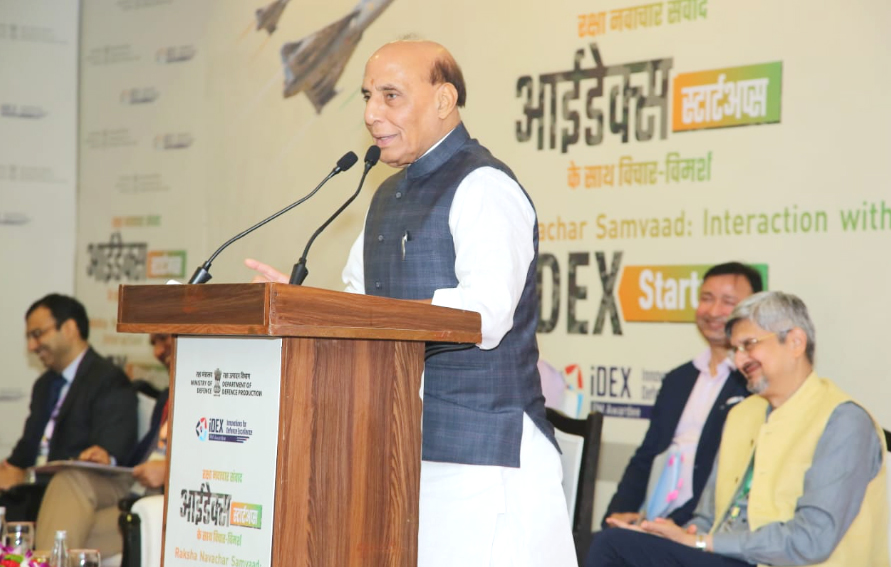| Rajnath Singh calls for collective national resolve to build self-reliant defence ecosystem | | India targets defence production worth Rs 3 lakh crore, exports worth Rs 50,000 crore by 2029 | |  Early Times Report Early Times Report
New Delhi, Oct 7: Defence Minister Rajnath Singh on Monday said that the defence and security are the collective responsibility of the entire nation, and strengthening the defence sector is not just the duty of one institution or government but the shared resolve of all Indians.
Speaking at the inauguration of the National Conference on Opportunities of Defence Manufacturing in the Country at Vigyan Bhawan, here, the Raksha Mantri urged all States and Union Territories to become active partners in building a robust, globally competitive defence manufacturing ecosystem.
“Self-reliance in defence is not just a matter of production or economy for us—it is first and foremost a matter of strategic autonomy directly linked to our sovereignty,” he said, highlighting India’s commitment to the Aatmanirbhar Bharat vision in the defence sector.
India’s Defence Growth Story
Rajnath Singh underscored India’s unprecedented progress in defence manufacturing over the last decade. He noted that India’s defence production has grown from Rs 46,000 crore in 2014 to over Rs 1.5 lakh crore in 2025 — the highest ever recorded — with the private sector contributing over Rs 33,000 crore.
Defence exports, he added, have surged from less than Rs 1,000 crore in 2014 to Rs 23,500 crore in 2025. “This remarkable journey from being one of the world’s largest importers of defence equipment to becoming a trusted exporter of defence systems is a testament to our national resolve,” he said.
Ambitious Targets for 2029
Reaffirming Prime Minister Narendra Modi’s vision of a self-reliant India, the Defence Minister said the country aims to achieve defence manufacturing worth Rs 3 lakh crore and exports worth Rs 50,000 crore by 2029. “It’s about confidence — that in times of crisis, we will not depend on others for our defence. Our soldiers should use weapons designed and built on our own soil,” he remarked.
Reforms and Policy Initiatives
To boost indigenous production, Rajnath Singh released a Compendium of State Policies on Defence and Aerospace Manufacturing, which consolidates policies and best practices from across States and UTs. He termed the compendium a vital tool for policy alignment between the Centre and the States, encouraging competition and collaboration in attracting defence investments.
Highlighting reforms to promote ease of doing business, the Minister noted simplifications in Quality Assurance timelines through self-certification, the launch of the Centralised Defence Testing Portal, and the Defence Testing Infrastructure Scheme (DTIS). He said frameworks like the Defence Acquisition Procedure (DAP) 2020, Defence Procurement Manual (DPM) 2025, Defence Offsets Policy, and the Defence Investor Cell are being continuously refined to encourage innovation, investment, and technology absorption.
Harnessing Technology and Innovation
Emphasizing the importance of advanced technologies, the Raksha Mantri said, “Modern warfare is not only about weapons but also about Artificial Intelligence, Robotics, Quantum Computing, Cyber, and Space technologies. We must make intellectual investments in frontier technology much more than physical investments.”
The conference also saw the launch of the Defence Exim Portal—a single-window digital platform for defence exports and imports—and SRIJAN-DEEP (Defence Establishments and Entrepreneurs Platform), a repository mapping Indian defence industries and their products.
Empowering MSMEs, Startups, and Women
Addressing the needs of MSMEs and startups, Singh said the Ministry is simplifying payment systems and developing automated cash management tools to improve liquidity. He also highlighted the Nari Shakti initiative, which is increasing women’s representation in the Armed Forces, and the allocation of 25% of the Defence R&D budget for industry, startups, and academia.
The Minister further mentioned the approval of 100 new Sainik Schools under a partnership model, alongside the expansion of the Border Roads Organisation’s budget to enhance border infrastructure.
Collaborative Federal Approach
Calling for coordination between the Centre and States on defence land management, Rajnath Singh said an online portal has been launched to facilitate proposals for public utility projects on defence land. “Approximately 1.8 million acres of defence land are spread across States, and coordinated management is crucial for preventing disputes and ensuring national security,” he said.
High-Level Participation
The conference, organised by the Department of Defence Production (DDP), was attended by Chief of Defence Staff General Anil Chauhan, the Chiefs of the Army, Navy, and Air Force, DRDO Chairman Dr Samir V. Kamat, senior officials from the Ministry of Defence, and representatives from State and Union Territory governments.
The event also featured the release of the iDEX Coffee Table Book: Shared Horizons of Innovation, showcasing the achievements of India’s flagship innovation ecosystem in defence, and underlined India’s march toward becoming a global hub for defence manufacturing and exports by 2047 under the vision of Viksit Bharat. |
|
